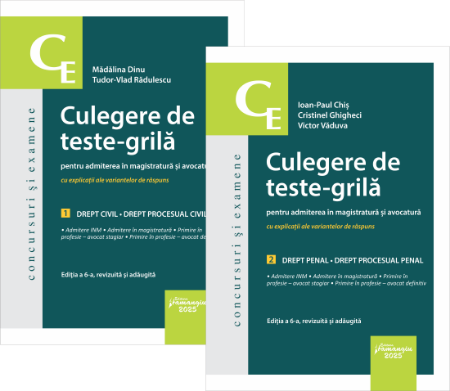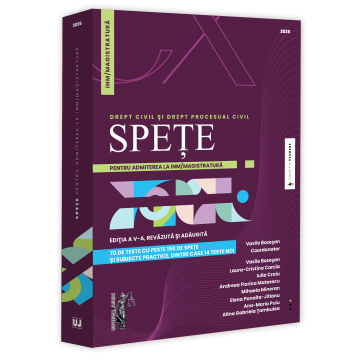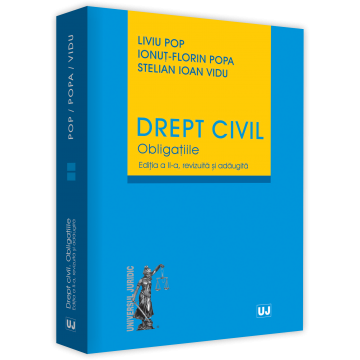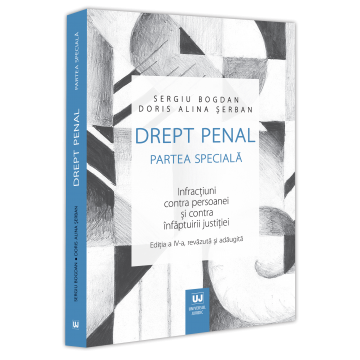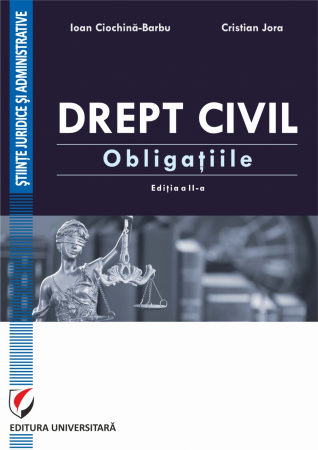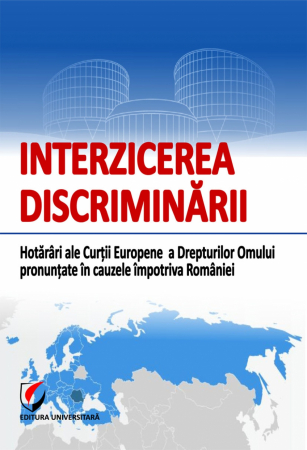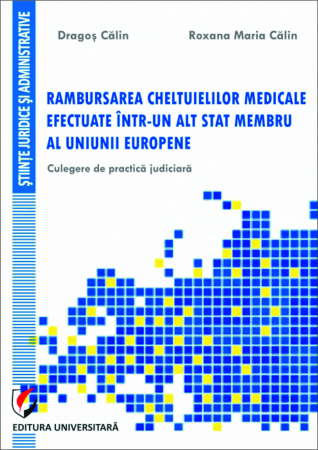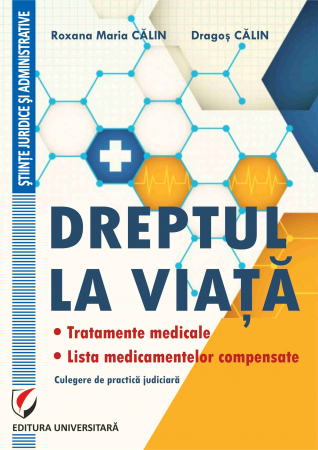Manuscript proposals: [email protected] / 0745 204 115 //// Tracking orders Individuals / Sales: 0745 200 357 / Orders Legal entities: 0721 722 783
Publisher: Editura Universitară
Author: Nicolae Ploesteanu, Raul Miron
Edition: I
Pages: 132
Publisher year: 2024
ISBN: 978-606-28-1764-0
DOI: 10.5682/9786062817640
Product Code:
9786062817640
Do you need help?
0745 200 357
- Download (1)
- Content
- More details
- Reviews (0)
-
Protectia internationala a drepturilor omului. Manual pentru uzul studentilor - Nicolae Ploesteanu, Raul Miron
Download
FOREWORD / 5
ABBREVIATIONS / 9
I. INTRODUCTION / 11
II. THE ROLE OF THE ESTABLISHMENT OF INTERNATIONAL HUMAN RIGHTS PROTECTION ORGANIZATIONS / 15
III. INTERNATIONAL GOVERNMENTAL ORGANIZATIONS (OGI) AND NON-GOVERNMENTAL ORGANIZATIONS (NGO) / 22
A. Security Council of the United Nations / 23
1. The role and powers of the Security Council / 23
2. Powers of the Security Council in the field of human rights / 24
B. The Council for Human Rights, successor of the Former Commission for Human Rights / 27
1. The history of the Council and a retrospective on the Commission's activity / 27
2. Advisory Committee / 32
3. UPR – Universal periodic reporting / 33
C. Organs of the treaties / 37
1. Committee for Human Rights (Committee) / 38
2. Committee for Economic, Social and Cultural Rights (CESCR) / 40
3. Committee on the Elimination of Discrimination against Women (CEDAW) / 41
D. The High Commissioner for Human Rights (HCHR) / 42
E. International Criminal Tribunals and the International Criminal Court / 43
IV. THE INTERACTIONS BETWEEN INSTITUTIONS AND SYSTEMS IN THE EXERCISE OF PRESSURE ON SOME GUILTY STATES / 46
A. The complex network of international intergovernmental organizations (IGO) and international non-governmental organizations (ONGI) / 46
B. Regional international systems for the protection of human rights / 49
1. The European protection system. The Council of Europe and the European Court of Human Rights / 49
2. American protection system / 50
3. The African system for the protection of human rights / 51
V. CHARACTERISTICS OF HUMAN RIGHTS RELEVANT TO THE NATURE OF PROTECTION / 53
A. Most human rights violations generally occur within a single state and affect the population of only one state / 54
B. Human rights violations frequently have a systematic character and reflect deep aspects of the political structure of a state / 58
C. Extension of obligations in the field of human rights to non-state actors / 62
D. The progressive realization of civil and political rights / 66
E. The duty of states to promote human rights and transform society. Cultural and technological obstacles / 70
VI. CONCLUSIONS / 81
SELECTIVE BIBLIOGRAPHY / 83
BAREM SUBJECTS / 87
UNIVERSAL DECLARATION OF HUMAN RIGHTS / 101
ACCUSATIONS REGARDING CRIMES OF GENOCIDE UNDER THE CONDITIONS OF THE CONVENTION FOR THE PREVENTION AND REPRESSION OF THE CRIME OF GENOCIDE / 109
ABBREVIATIONS / 9
I. INTRODUCTION / 11
II. THE ROLE OF THE ESTABLISHMENT OF INTERNATIONAL HUMAN RIGHTS PROTECTION ORGANIZATIONS / 15
III. INTERNATIONAL GOVERNMENTAL ORGANIZATIONS (OGI) AND NON-GOVERNMENTAL ORGANIZATIONS (NGO) / 22
A. Security Council of the United Nations / 23
1. The role and powers of the Security Council / 23
2. Powers of the Security Council in the field of human rights / 24
B. The Council for Human Rights, successor of the Former Commission for Human Rights / 27
1. The history of the Council and a retrospective on the Commission's activity / 27
2. Advisory Committee / 32
3. UPR – Universal periodic reporting / 33
C. Organs of the treaties / 37
1. Committee for Human Rights (Committee) / 38
2. Committee for Economic, Social and Cultural Rights (CESCR) / 40
3. Committee on the Elimination of Discrimination against Women (CEDAW) / 41
D. The High Commissioner for Human Rights (HCHR) / 42
E. International Criminal Tribunals and the International Criminal Court / 43
IV. THE INTERACTIONS BETWEEN INSTITUTIONS AND SYSTEMS IN THE EXERCISE OF PRESSURE ON SOME GUILTY STATES / 46
A. The complex network of international intergovernmental organizations (IGO) and international non-governmental organizations (ONGI) / 46
B. Regional international systems for the protection of human rights / 49
1. The European protection system. The Council of Europe and the European Court of Human Rights / 49
2. American protection system / 50
3. The African system for the protection of human rights / 51
V. CHARACTERISTICS OF HUMAN RIGHTS RELEVANT TO THE NATURE OF PROTECTION / 53
A. Most human rights violations generally occur within a single state and affect the population of only one state / 54
B. Human rights violations frequently have a systematic character and reflect deep aspects of the political structure of a state / 58
C. Extension of obligations in the field of human rights to non-state actors / 62
D. The progressive realization of civil and political rights / 66
E. The duty of states to promote human rights and transform society. Cultural and technological obstacles / 70
VI. CONCLUSIONS / 81
SELECTIVE BIBLIOGRAPHY / 83
BAREM SUBJECTS / 87
UNIVERSAL DECLARATION OF HUMAN RIGHTS / 101
ACCUSATIONS REGARDING CRIMES OF GENOCIDE UNDER THE CONDITIONS OF THE CONVENTION FOR THE PREVENTION AND REPRESSION OF THE CRIME OF GENOCIDE / 109
The international protection of human rights can only be described if the system of states is taken into account, because it provides us with the first line of defense of rights and is intertwined in a very complex manner with the system of international organizations, respectively with their procedures. The very notion of "protection" must be reconsidered in the context of human rights, so that it extends beyond the conventional meaning of jurisdictions and the meaning of other forms of law enforcement, or of the provisions corresponding to civil remedies. The need for reconsideration stems from several characteristics of the phenomenon of human rights, which distinguish it from most fields of international law. The dynamics of this phenomenon is influenced by the current stage of development of technology and the great principles of international law, here remembering in particular the principle of sovereignty and sovereign equality of states, respectively the principle of cooperation between states.
The characteristics of the human rights phenomenon highlight the depth of the effects of human rights on the culture and political and social structure of a state. In many authoritarian states and developing states where strong conflicts are taking place, it is much more effective to understand protection as one of the means of changing the political, ideological and cultural currents that are supposed to be at the basis of the violations. Without such changes, even if violations of fundamental rights can be temporarily interrupted, the risk of their recurrence will persist.
In the light of these observations, it can be stated that - especially outside the circle of states with liberal democracies where such rights are familiar and rooted and the innovations and consolidation of these rights are absorbed, in general, easily - numerous civil and political rights can only be defended in an evolutionary, progressive form. The evaluation of the effectiveness of treaties in the field of human rights must be a continuous process, which takes into account the expansion of the field but also, in the long term, the possibilities that are generated by political and cultural transformations. Depending on the source from which they come, there can be different points of view on this issue regarding the immediate or progressive defense of some rights; such sources can be: victims of violations; lawyers specialized in the field of human rights; teachers, critical observers of the human rights phenomenon. In particular, when it comes to cultural rights, a long-term action is necessary, in other words, a progressive but constant defense. Unfortunately, sometimes only special events can lead to the removal of cultural barriers. A sad example is the current situation of Ukraine: in the context in which the only way to a future post-war stability, which will meet the aspirations of the majority of its population, is to concretely recognize the rights of some minorities located on its territory, President Volodymyr Zelenskiy showed the intention to create bilateral legal instruments with neighboring countries of Ukraine regarding the protection of national minorities and the use of national languages (Vulcan, 2023).
The issue of human rights protection has a deceptive simplicity. It seems to look more at international norms, organizations and phenomena that have contributed to the protection of human rights, than national political and legal institutions that can and do constitute the first line of defense against violations (Rodley, 2018, pg. 788-789). What must be brought into discussion in this framework, in relation to protection, is the series of pressures applied by international entities or by one or more states against the guilty state - critical diplomatic notes, investigative reports, recommendatory resolutions; court decisions or other dispute resolution documents; threats to suspend trade or aid; boycott and embargo; military interventions - in the effort to put an end to the violations and to increase the level of compliance of the guilty state's actions with the alleged requirements in the field of human rights. A current example is the war in Ukraine. The European Union imposed a series of sanctions on Russia in order to weaken its ability to finance the war and to generate certain economic and political expenses for the political elite from the Kremlin responsible for the invasion of Ukraine. The measures include sanctions on certain individuals, economic sanctions, media bans, diplomatic pressure measures, bans on economic relations with Donetsk and Luhansk regions. However, what is essential for the protection of human rights in a context that is of extreme complexity and sensitivity, consists in the actions of various organizations, states and communities that mobilized to support the people in the regions affected by the war with food, shelter or to offer them advice of various kinds (including legal, such as making an application for asylum or information related to moving to other countries, etc.). At the same time, a series of international organizations or specialized institutions of the European Union, of the UN carry out their activity of documenting war crimes or other international crimes on the spot (United Nations, 2023).
These aspects give the problem a much more complex character. What does an international protection system entail? In a world of human rights that so systemically affects the life of states, can we clearly identify the border between international institutions and phenomena, on the one hand, and national ones, on the other? At least in those international institutions where those targeted states are active parties, voting for the participation of other members? Should the incorporation into domestic law and the application of an international norm by a state be seen as pure matters of domestic law? Or do the systems of international law and domestic law present so many common issues and interconnections that a study is necessary regarding the interpenetrations between them and their complementarity? (Rodley, 2018)
The problematic aspect of the notion of protection concerns its extent. Could we understand the specific needs and challenges of the human rights phenomenon if we reduce the international protection of rights to the common meaning of protection: maintaining compliance with the law by applying it, respecting the conditions (in liberal states) imposed by the rule of law? Should the idea of human rights protection include, for example, an analysis and a reconsideration of basic conditions and traditional positions in such a way as to reach a greater acceptance of human rights norms? (Steiner, 2006)
Such questions regarding the international dimension of human rights and the notion of protection represent the key ideas of this manual. It will start from a more formal and positivist research. Section II of the manual includes an essay on the role of international organizations with human rights protection competences; the third section highlights the distinction and interpenetrations between the activities of intergovernmental organizations and international non-governmental organizations; in section IV, the institutional structure, powers and functions of some of the basic organizations and bodies in the field of human rights are described, showing their links with the states and highlighting the multitude of forms of protection they offer; in the fifth section, the features of the human rights phenomenon are presented, which distinguish it from all other fields of international law and some of the key issues concerning international protection.
The manual describes the universal system of human rights - universal by the number of its members and by the assumed goals - which is closely linked to the United Nations Organization. This system presents a great diversity due to its global participants who express ideological, cultural, political and socio-economic identities of a much larger scale than the three regional systems regarding human rights, from America, Africa and Europe. This diversity generates complex problems arising within the activities undertaken to ensure adequate protection.
Most of the analyzes carried out concern civil and political rights. Given their intrinsic importance and the status of equality in the category of economic, social and political rights, they are treated equally in the course.
The international protection of human rights acquires a new dimension due to the development of technology, as the speed of information circulation and the way in which it is received globally or regionally can lead to the transformation of some mechanisms categorized as internal, through the lens of the legislation, to mechanisms with an international vocation from the perspective of the consequences they produce to prevent or sanction human rights violations. As an example, we can mention the establishment by the members of the band Pussy Riot of the independent news service in Russia, called Mediazona, and whose main objective is to transmit information about the prison system in Russia and about human rights violations committed by law enforcement authorities ( Mediazone, 2023). For a summary of the topics of this section, see the topics from points 1-6.
The characteristics of the human rights phenomenon highlight the depth of the effects of human rights on the culture and political and social structure of a state. In many authoritarian states and developing states where strong conflicts are taking place, it is much more effective to understand protection as one of the means of changing the political, ideological and cultural currents that are supposed to be at the basis of the violations. Without such changes, even if violations of fundamental rights can be temporarily interrupted, the risk of their recurrence will persist.
In the light of these observations, it can be stated that - especially outside the circle of states with liberal democracies where such rights are familiar and rooted and the innovations and consolidation of these rights are absorbed, in general, easily - numerous civil and political rights can only be defended in an evolutionary, progressive form. The evaluation of the effectiveness of treaties in the field of human rights must be a continuous process, which takes into account the expansion of the field but also, in the long term, the possibilities that are generated by political and cultural transformations. Depending on the source from which they come, there can be different points of view on this issue regarding the immediate or progressive defense of some rights; such sources can be: victims of violations; lawyers specialized in the field of human rights; teachers, critical observers of the human rights phenomenon. In particular, when it comes to cultural rights, a long-term action is necessary, in other words, a progressive but constant defense. Unfortunately, sometimes only special events can lead to the removal of cultural barriers. A sad example is the current situation of Ukraine: in the context in which the only way to a future post-war stability, which will meet the aspirations of the majority of its population, is to concretely recognize the rights of some minorities located on its territory, President Volodymyr Zelenskiy showed the intention to create bilateral legal instruments with neighboring countries of Ukraine regarding the protection of national minorities and the use of national languages (Vulcan, 2023).
The issue of human rights protection has a deceptive simplicity. It seems to look more at international norms, organizations and phenomena that have contributed to the protection of human rights, than national political and legal institutions that can and do constitute the first line of defense against violations (Rodley, 2018, pg. 788-789). What must be brought into discussion in this framework, in relation to protection, is the series of pressures applied by international entities or by one or more states against the guilty state - critical diplomatic notes, investigative reports, recommendatory resolutions; court decisions or other dispute resolution documents; threats to suspend trade or aid; boycott and embargo; military interventions - in the effort to put an end to the violations and to increase the level of compliance of the guilty state's actions with the alleged requirements in the field of human rights. A current example is the war in Ukraine. The European Union imposed a series of sanctions on Russia in order to weaken its ability to finance the war and to generate certain economic and political expenses for the political elite from the Kremlin responsible for the invasion of Ukraine. The measures include sanctions on certain individuals, economic sanctions, media bans, diplomatic pressure measures, bans on economic relations with Donetsk and Luhansk regions. However, what is essential for the protection of human rights in a context that is of extreme complexity and sensitivity, consists in the actions of various organizations, states and communities that mobilized to support the people in the regions affected by the war with food, shelter or to offer them advice of various kinds (including legal, such as making an application for asylum or information related to moving to other countries, etc.). At the same time, a series of international organizations or specialized institutions of the European Union, of the UN carry out their activity of documenting war crimes or other international crimes on the spot (United Nations, 2023).
These aspects give the problem a much more complex character. What does an international protection system entail? In a world of human rights that so systemically affects the life of states, can we clearly identify the border between international institutions and phenomena, on the one hand, and national ones, on the other? At least in those international institutions where those targeted states are active parties, voting for the participation of other members? Should the incorporation into domestic law and the application of an international norm by a state be seen as pure matters of domestic law? Or do the systems of international law and domestic law present so many common issues and interconnections that a study is necessary regarding the interpenetrations between them and their complementarity? (Rodley, 2018)
The problematic aspect of the notion of protection concerns its extent. Could we understand the specific needs and challenges of the human rights phenomenon if we reduce the international protection of rights to the common meaning of protection: maintaining compliance with the law by applying it, respecting the conditions (in liberal states) imposed by the rule of law? Should the idea of human rights protection include, for example, an analysis and a reconsideration of basic conditions and traditional positions in such a way as to reach a greater acceptance of human rights norms? (Steiner, 2006)
Such questions regarding the international dimension of human rights and the notion of protection represent the key ideas of this manual. It will start from a more formal and positivist research. Section II of the manual includes an essay on the role of international organizations with human rights protection competences; the third section highlights the distinction and interpenetrations between the activities of intergovernmental organizations and international non-governmental organizations; in section IV, the institutional structure, powers and functions of some of the basic organizations and bodies in the field of human rights are described, showing their links with the states and highlighting the multitude of forms of protection they offer; in the fifth section, the features of the human rights phenomenon are presented, which distinguish it from all other fields of international law and some of the key issues concerning international protection.
The manual describes the universal system of human rights - universal by the number of its members and by the assumed goals - which is closely linked to the United Nations Organization. This system presents a great diversity due to its global participants who express ideological, cultural, political and socio-economic identities of a much larger scale than the three regional systems regarding human rights, from America, Africa and Europe. This diversity generates complex problems arising within the activities undertaken to ensure adequate protection.
Most of the analyzes carried out concern civil and political rights. Given their intrinsic importance and the status of equality in the category of economic, social and political rights, they are treated equally in the course.
The international protection of human rights acquires a new dimension due to the development of technology, as the speed of information circulation and the way in which it is received globally or regionally can lead to the transformation of some mechanisms categorized as internal, through the lens of the legislation, to mechanisms with an international vocation from the perspective of the consequences they produce to prevent or sanction human rights violations. As an example, we can mention the establishment by the members of the band Pussy Riot of the independent news service in Russia, called Mediazona, and whose main objective is to transmit information about the prison system in Russia and about human rights violations committed by law enforcement authorities ( Mediazone, 2023). For a summary of the topics of this section, see the topics from points 1-6.
If you want to express your opinion about this product you can add a review.
write a review

6359.png)
![International protection of human rights. Manual for students' use - Nicolae Ploesteanu, Raul Miron [1] International protection of human rights. Manual for students' use - Nicolae Ploesteanu, Raul Miron [1]](https://gomagcdn.ro/domains/editurauniversitara.ro/files/product/large/protectia-internationala-a-drepturilor-omului-manual-pentru-uzul-studentilor-nicolae-ploesteanu-raul-miron-439158.jpg)

